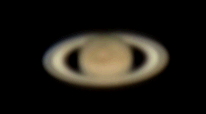Imaging: Venus, Moon, Europa Shadow, Saturn Moons, Saturn
Posted: 25 May 2015
Clouds returned on Sunday, 24 May 2015, but the cloud cover decreased late in the afternoon.
|
Open: Sunday, 24 May 2015, 1812 MST Temperature: 86°F |
Session: 824 Conditions: Mostly clear, breezy |
Synced observatory clock to WWV. 1821 MST: viewed Venus, 83X. Switched to the Baader 8-24mm Zoom Eyepiece. Seeing was not very good but the view at 250X was fairly good at times. This is a cropped handheld iPhone 5s afocal photo, 250X:

1830 MST: viewed Jupiter, 83X to 250X. No moons visible (yet). Then did some lunar observing, 83X-250X. The central peaks in the crater Theophilus looked nice again this night at 250X during moments of good seeing. 1854 MST: back to Jupiter; still no moons. 1859 MST: two moons, Ganymede and Io, now visible. Europa was in transit and not visible. 1914 MST: Callisto became visible. 1924 MST: sunset.
Switched to 1.25" 9mm (222X) eyepiece and the MX-1 Afocal Adapter. This full-frame iPhone afocal 222X photo shows the craters Theophilus, Cyrillus, and Catharina at center:

This full-frame image from the iPhone is also at 222X but with some digital zoom on the camera:

Rima (rille) Ariadaeus was distinctly visible. This cropped iPhone afocal 222X photo shows it:

1943 MST: back to Jupiter for the start of the Europa shadow transit. 1947 MST: shadow was visible, 222X. Seeing still not good. This stack of 1168 frames (iPhone 5s slo-mo video, 120 fps, 10 seconds), afocal 444X, shows the shadow at the right:

I then observed the shadow transit and saw Europa as it approached the the planet's limb as a bright star-like object against the bright clouds. Seeing continued to worsen; the best view was at 125X.
2015 MST: Saturn had risen above the hill to the southeast but was still in the tree. Slewed to it and had some occasional views of the planet and the moon Titan. 2055 MST: Saturn was above the tree. Three moons were visible at 83X: Iapetus, Rhea, and Titan. 2058 MST: the moons Tethys and Dione became visible. After taking a short break, I set up for D7200 DSLR imaging of Saturn moons even though seeing was still not very good. Mounted the DSLR at prime focus + 2X PowerMate; did a focus test on the star Spica using the Bahtinov Mask. This cropped image shows five moons (and the overexposed planet):

Mouseover or tap on image to see labels
2330 MST: removed the DSLR and mounted the iPhone 5s. This is a stack of 2366 frames (slo-mo video; 20 seconds), afocal 222X:

This is a stack of 1161 frames (slo-mo video; 20 seconds), afocal 444X:

Unfortunately, a "dust donut" appeared on the planet's disk.
2340 MST: done imaging. Did some Saturn observing, 83X-250X, but seeing was still not very good.
|
Close: Monday, 25 May 2015, 0003 MST Temperature: 58°F |
|
Comments are welcome using Email. If you are on Twitter you can use the button below to tweet this report to your followers. Thanks.
Cassiopeia Observatory Home Page
Copyright ©2015 Michael L. Weasner / mweasner@me.com
URL = http://www.weasner.com/co/Reports/2015/05/25/index.html
